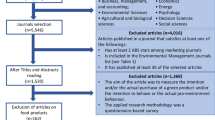Abstract
Sustainability analyses of systems are successful when one can ascertain unambiguous overall superiority of a state of a system compared to alternative states. These alternative states can be system conditions over time intervals, or alternative products or processes for the same function or market application. In such analyses, indicators or metrics that satisfactorily characterize the system can be used to obtain an aggregate index for easy decision making. Previously, the geometric mean of the ratios of the applied indicators was demonstrated to be useful in showing superior or inferior status of any specific state of the system compared to a chosen reference state. This multidimensional index D, in a pairwise comparison, however, does not work if any indicator can assume the value of zero, infinity, or negative numbers. The present work shows that by shifting the multidimensional reference point, this difficulty can be easily avoided. In addition, this technique of shifting the reference point also has been shown to work when the standard multidimensional Euclidean distance, i.e., the square root of the sum of the squares of the differences of the indicator values, appropriately normalized, is used to differentiate among competing alternatives for determining comparative sustainability. Two sets of data, one on fender designs for automobiles, and the other on alternate means of treating automotive shredder residues, were used to illustrate the application of the indicator integration.




Similar content being viewed by others
References
Bell S, Morse S (2003) Measuring sustainability. Earthscan Publications Ltd., London
Hak T, Moldan B, Dahl AL (2007) Sustainability indicators. Island Press, Washington, DC
Saur C, Fava J, abd Spatari S (2000) Life cycle engineering case study: automobile fender designs. Env Prog 19(2):72–82
Shonnard DR, Kirchner A, Saling P (2003) Industrial applications using BASF eco-efficiency analysis: perspectives on green engineering principles. Env Sci Technol 37:5340–5348
Sikdar SK (2003) Sustainable development and sustainability metrics. AIChE J 49(8):1928–1932
Sikdar SK (2009) On aggregating multiple indicators into a single metric for sustainability. Clean Tech Env Policy 11:157–161
Vermeulen I, Block C, Van Caneghem J, Dewulf W, Sikdar S, Vandecasteele C, (2012) Sustainability assessment of industrial waste treatment processes. Application to ASR. Submitted to Resour Conserv Recycl
Acknowledgments
This work was supported by the Office of Research and Development of the U.S. Environmental Protection Agency.
Author information
Authors and Affiliations
Corresponding author
Additional information
Debalina Sengupta—ORISE post-doctoral fellow at the US EPA.
Rights and permissions
About this article
Cite this article
Sikdar, S.K., Sengupta, D. & Harten, P. More on aggregating multiple indicators into a single index for sustainability analyses. Clean Techn Environ Policy 14, 765–773 (2012). https://doi.org/10.1007/s10098-012-0520-3
Received:
Accepted:
Published:
Issue Date:
DOI: https://doi.org/10.1007/s10098-012-0520-3




